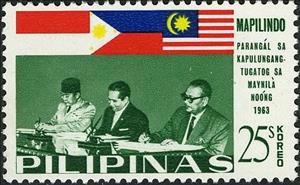Stamp: Presidents Sukarno and Macapagal (Philippines 1965)
Presidents Sukarno and Macapagal (Philippines 1965)
25 November (Philippines ) within release Signing of Manila Agreement goes into circulation Stamp Presidents Sukarno and Macapagal face value 25 Philippine sentimo
| Stamp Presidents Sukarno and Macapagal in catalogues | |
|---|---|
| Michel: | Mi:PH 789 |
| Stanley Gibbons: | Sg:PH 1007 |
| Stamp Number: | Sn:PH 938 |
| Yvert et Tellier: | Yt:PH 632 |
Stamp is horizontal format.
Also in the issue Signing of Manila Agreement:
- Stamp - Presidents Sukarno and Macapagal face value 25;
- Stamp - Presidents Sukarno and Macapagal face value 6;
- Stamp - Presidents Sukarno and Macapagal face value 10;
Stamp Presidents Sukarno and Macapagal it reflects the thematic directions:
A flag is a piece of fabric (most often rectangular or quadrilateral) with a distinctive design that is used as a symbol, as a signaling device, or as decoration. The term flag is also used to refer to the graphic design employed, and flags have since evolved into a general tool for rudimentary signalling and identification, especially in environments where communication is similarly challenging (such as the maritime environment where semaphore is used). National flags are patriotic symbols with varied wide-ranging interpretations, often including strong military associations due to their original and ongoing military uses. Flags are also used in messaging, advertising, or for other decorative purposes. The study of flags is known as vexillology, from the Latin word vexillum, meaning flag or banner.
A people is a plurality of persons considered as a whole, as is the case with an ethnic group or nation. Collectively, for example, the contemporary Frisians and Danes are two related Germanic peoples, while various Middle Eastern ethnic groups are often linguistically categorized as Semitic peoples.


